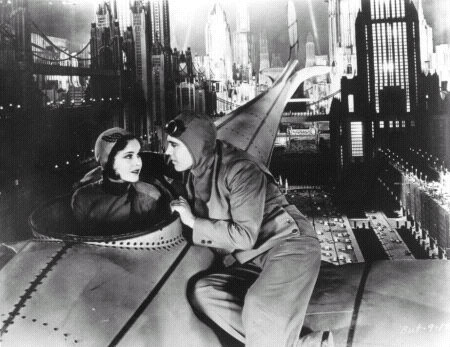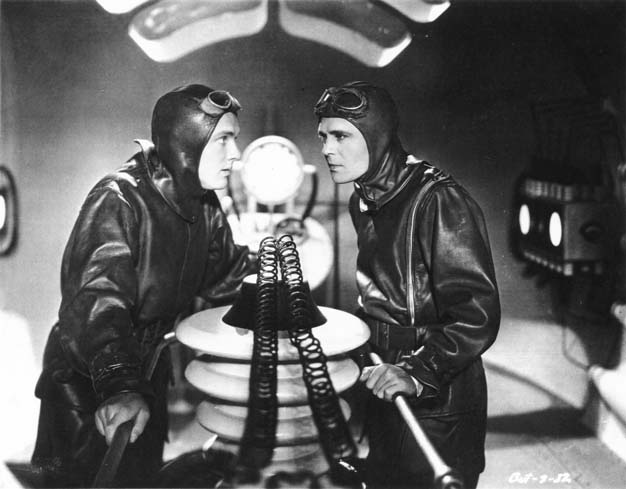‘Just Imagine’ Screening and Q&A
 On Sunday, August 19th, at the Aero Theatre in Santa Monica, CA, I was happy and intrigued to be able to sit in on a screening of the 1930 film Just Imagine. Just Imagine was an American science-fiction musical, which was made to counter the 1927 German science-fiction film Metropolis. It is a film that is rarely seen these days, but is one that has inspired many famed science fiction films since. Along with the screening of the film, this event also featured a pre-show honoring of the film’s production designer, Stephen Gooson, along with a post-show Q&A with Professor Nicholas Cull, who has written books about the effect of science fiction in pop culture. Continue on to learn more about this film and to hear audio of the pre- and post-show discussions that took place.
On Sunday, August 19th, at the Aero Theatre in Santa Monica, CA, I was happy and intrigued to be able to sit in on a screening of the 1930 film Just Imagine. Just Imagine was an American science-fiction musical, which was made to counter the 1927 German science-fiction film Metropolis. It is a film that is rarely seen these days, but is one that has inspired many famed science fiction films since. Along with the screening of the film, this event also featured a pre-show honoring of the film’s production designer, Stephen Gooson, along with a post-show Q&A with Professor Nicholas Cull, who has written books about the effect of science fiction in pop culture. Continue on to learn more about this film and to hear audio of the pre- and post-show discussions that took place.
Here is the Official Press Release Regarding this event:
The Art Directors Guild Film Society and The American Cinematheque
Present:
JUST IMAGINE
(1930)
Sunday, August 19, 2012
Aero Theatre 1328 Montana Ave., Santa Monica
Sponsored by The Hollywood Reporter
In 1930, Hollywood produced a romantic science fiction musical comedy!
Though Just Imagine was reportedly inspired by the grim Metropolis (1927), this rarely seen film is a fascinating musical comedy set in the then unimaginably distant future of 1980 – a future of personal airships and rockets to Mars – starring Maureen O’Sullivan, El Brendel, John Garrick, and the exotic “Joyzelle.” The program, sponsored by The Hollywood Reporter, will explore the film’s place at the very beginning of futurism in American movies, as well as honor the film’s legendary Oscar®-winning Production Designer Stephen Goosson for his major design contributions to this highly influential film.
Just Imagine, a very expensive film, was considered only a modest success in its time and almost forgotten. Today it has become something of a “lost” film and nearly impossible to see on the big screen. “While the beautiful art deco sets, enormous miniatures, and remarkable projection effects still amaze,” says Production Designer John Muto, Founder of the ADG Film Series, “the music, comedy, and love story are derived from vaudeville and must have seemed very dated as cinematic musicals exploded in the 1930s. I suspect that may be why the film faded from view. Our audience will discover a very surprising film!”
“The art direction in Just Imagine is unforgettable by any standard,” said Muto. The centerpiece of the film, an enormous miniature of a future New York City, filled an airship hanger in Arcadia, required more than 200 craftsmen working over five months to build, and cost $250,000 in 1930 dollars! Besides the many classy art deco settings, the film includes a remarkable laboratory set – the first to feature the Kenneth Strickfaden electrical equipment later made famous in the Frankenstein films. The fantastic rocketship created for the film went on to become Flash Gordon’s trademark spaceship in the most successful serial of all time. “Given that Just Imagine had such a unique and unconventional look for its day, it was a remarkable tribute to Mr. Gooson when he was recognized with a nomination for the Best Art Direction Oscar of 1930.”
After the feature, a series of clips illustrating the influence of Just Imagine on such films as The Fifth Element (1997), Blade Runner (1982), Minority Report (2002), Things To Come (1936), Logan’s Run (1976), Brazil (1985), Soylent Green (1973), and Sleeper (1973) will be run.
A Q&A will follow, moderated by Muto, which will feature Nicholas Cull, Professor of Public Diplomacy at USC’s Annenberg School. Cull’s books include Projecting Empire: Imperialism and the Popular Cinema and the forthcoming Projecting Tomorrow: Science Fiction and the Popular Cinema.
Just Imagine’s Production Designer, Stephen Goosson (1889 – 1973), was Columbia Pictures’ supervising art director for 25 years. A gifted artist, he is responsible for the look of some of the most memorable films in Hollywood history. Goosson worked for a number of pioneer film companies including Lewis J. Selznick, Mary Pickford Productions, Frank Lloyd, DeMille Pictures, and Fox, before being hired by Columbia. Nominated for five Academy Awards®, Goosson won for his magnificent Shangri-La set for Frank Capra‘s Lost Horizon (1937). A very short selection of his other memorable film designs might include The Lady From Shanghai (1947), Gilda (1946), The Little Foxes (1941), Meet John Doe (1941), Mr. Deeds Goes to Town (1936), and It Happened One Night (1934).
To add some of my own thoughts in regards to this event, the film was certainly an interesting watch. I could see many ways in which Just Imagine could be seen as ahead of its time, even when getting past some of the more humorous aspects that emerge due to the general strangeness of the story being presented. The depiction of the year 1980 was a neat way to get an understanding of how America essentially was in the 30s and what the imaginations of those involved in this film’s production were like, when it came to interpreting a future society. Adding the musical aspect and keeping the tone light was also an interesting, yet typically American way of adapting to the idea of creating a sci-fi spectacle. Aside from maybe a few examples, it is somewhat surprising that sci-fi films have not incorporated musical numbers and would have me intrigued were that to occur in the future. Lastly, not knowing that this film would eventually journey to Mars, I found the whole way that played out to be both confusing but interesting at the same time. It did not help that the print was not the greatest to see the film on, but learning more about what inspired this aspect of the story and the sets involved would surely be interesting.
Below I have embedded the recording of the pre- and post-show discussions, which will delve more into what I have only touched upon. The first part of this recording contains an introduction from moderator John Muto, followed by a small honoring of production designer Stephen Gooson. The recording then jumps to after the screening where Muto engages Prof. Nicholas Cull in a conversation regarding Just Imagine and its effects on science fiction in pop culture, along with the art/production design involved. I should note that the recording is lengthy, a bit rough, and the audio is kind of low at points, but hopefully contains enough insight for anyone interested. If the Art Directors Guild posts their own version of this Q&A event, I will try to update the post with that link. Additionally, I also hope the ADG will post the video clips they put together, which related to Gooson’s work as well as the other science fiction films that were influenced by Just Imagine. Anyway, enjoy the audio.























Nice! Good coverage!